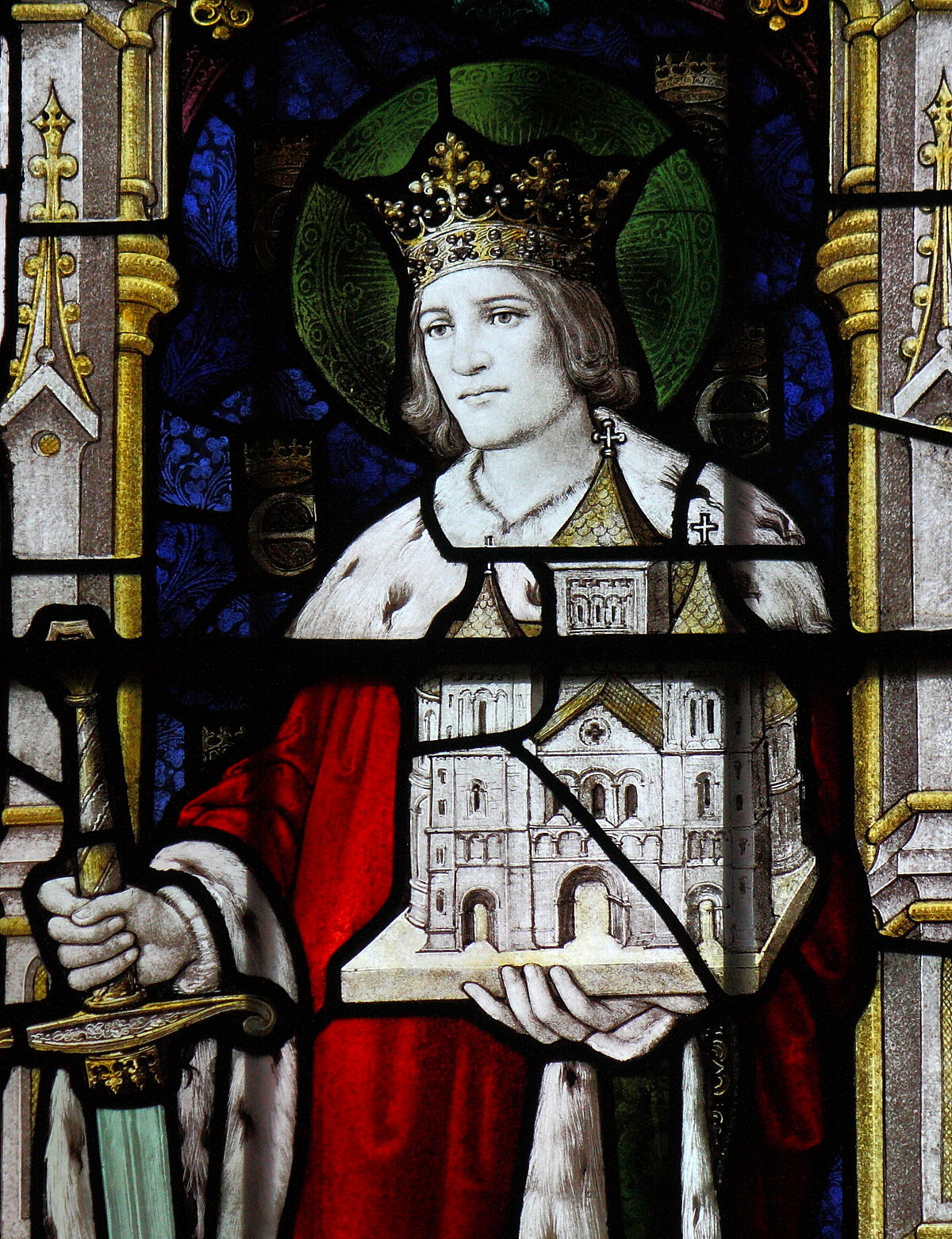Dec-2020
The King at West Heslerton
Visit St. Mary’s Church at Sledmere and you will find a stained glass depiction of King Edwin of Northumbria. The King, now raised to sainthood, is clutching a broad sword, but it is the large stone church he is cradling that is the focus of attention.
Edwin’s legacy is not only the Archbishopric of York, it is no less than the establishment of a Christian Anglo-Saxon State, the building blocks of modern Britain and, by definition, a model that would be followed from the Americas to Australia and wherever English-speaking peoples settled.
Although Edwin’s story straddles Britain, and even into the Irish Sea and onto the Continent, its heartland was on the slopes of the Yorkshire Wolds, around what are today the sleepy villages of West Heslerton and Place Newton.
In the previous story of Northumbria, we saw how the exile Edwin pledged to convert to Christianity after being visited by a stranger the night before he was due to be executed. He was spared and swept north in 616 with an army bent on placing the crown of Northumbria on Edwin’s head. At Bawtry in South Yorkshire, the pretender to the Northumbrian crown, Edwin confronted King Æthelfrith (actually his brother-in-law as Æthelfrith’s wife Achaon was Edwn’s sister) on the banks of the River Idle. Edwin trapped his brother-in-law between the banks of the Rivers Idle and Trent and won a victory that would reshape both the lands North of the Humber (Northumbria) and in turn the English speaking world.
King Æthelfrith was killed in the battle and thus Edwin was proclaimed King of Northumbria. As news spread of Æthelfrith’s death, one of his sons, Oswald fled northwards to safety and to the Inner-Hebridean island of Iona. As Æthelfrith was haunted by Edwin, so Edwin would be haunted by his nephew Oswald and for many long years Oswald would, under the tutelage of St. Columba, plan his return to Northumbria.
By 619 Edwin had annexed the sub-kingdom of Elmet (essentially West Yorkshire), thus securing his western border. Edwin now controlled all of modern day Yorkshire, County Durham and Northumberland. Cumbria was allied to him and it was from there around 620 that he launched a maritime incursion into the Irish Sea. The Isle of Man and Anglesey were his targets. This was not so much an invasion, but a raid to make the islands vassal states to Northumbria.
Edwin further extended his influence when in 625 he married Princess Æthelburh. She was the sister of King Eadbald of Kent. Thus Edwin, already militarily the most powerful English king, now through marriage enjoyed alliances with Kent and Francia (the precursor of modern day France). Among the wedding party heading northwards with Princess Æthelburh was the missionary Paulinus, destined to become the first Bishop of York and the architect of the first Christian church to be built in England for 200 years, probably on the site of York Minster. As part of the marriage agreement, Edwin promised to be formally baptised. Pope Boniface sent a letter to Edwin, describing him as the ‘illustrious King of the English’. A golden robe was a wedding gift to Edwin and Æthelburh received a silver mirror and an ivory comb.
Although these gifts, and the Pope’s blessing, were important to Edwin, he seems to have been in two minds about the baptism. Perhaps he was weighing up the practicalities of becoming a Christian king in a land where the faith barely had a toe hold? By 627 he decided to formally convert to Christianity. The exact location of this momentous event is unknown, but probable locations range from a splendid Early Medieval Palace at Place Newton near Wintringham, or perhaps the large (by the standard of the times) settlement at West Heslerton. The conversion of King Edwin, and concurrently the political elite of Deira (Eastern Yorkshire), took place in a Beowulfian mead hall. It was followed by a similar ceremony at Yeavering in Northumberland with the elite of Bernicia (the lands north of the Tees) and thus Northumbria became a Christian land.
It has been argued that Edwin’s actions laid the foundations of a Christian Anglo-Saxon State. If true, the ramifications are enormous, as it set the template for the modern nation state, a template that would not only be followed in Britain, but whose echo can be found in the English speaking nations of the world, from North America to Australia. It might seem astonishing to modern eyes that sleepy Place Newton or West Heslerton hosted such an event. But in Dark Age Britain, the area around West Heslerton, was a relatively densely populated area whose inhabitants had access to imported dyestuffs and leather goods obtained from beach markets one of which is thought to have been at Filey.
The actual baptism of Edwin took place at York, probably on the site of the Minster, on Easter Sunday, 12 April 627. Edwin established York as a seat of ecclesiastical power and led a parallel restoration of the Roman walls. Perhaps Edwin wished to bask in the reflective glory of York as the city where Constantine the Great was proclaimed Emperor of the Roman Empire in 306? That is unknowable, but Edwin undoubtedly transformed York into a focal point for the Kingdom of Northumbria and Christianity in these islands. Part of that legacy is York Minster and the office of the Archbishop of York. After his baptism, to reinforce the fact that Northumbria was now a Christian kingdom, Edwin ordered Goodmanham in East Yorkshire, a major pagan temple site, to be burned to the ground.
Five years later in 623 Northumbria was invaded. An allied army comprising of the pagan King Penda of Mercia (the English midlands) and Cadwallon king of Gwynedd (who had been humiliated by Edwin’s Irish Sea raid a few years earlier). The incursion was around where the Great North Road meets the Roman Road from Lichfield at Doncaster. Edwin took his army south and on 12 October 623 they met at what is known as the Battle of Hatfield Chase. Little is known of the actual battle, even its location remains disputed, but Edwin was killed and his army routed. The Venerable Bede described it, and the aftermath, as ‘the darkest days in the history of Northumbria’. Cadwallon ravaged the almost defenceless land. Villages burned, livestock was raided and Queen Æthelburh, along with Paulinus, Bishop of York, fled to exile in Kent.
However, as Northumbria burned, on the Isle of Iona plans were being laid for the return of Oswald. So long in exile, he set his plans for lightning sea-borne attack on Cadwallon, whose army was encamped near Hexham in the Tyne Valley.
But what of Edwin? What is his legacy? After his death, Edwin came to be venerated as a saint. The fact that Edwin died in battle against a pagan army, and he established York as a seat of ecclesiastical power, allowed Edwin to be perceived as a martyr. Visit St Mary’s Church at Sledmere and you can gain an echo of those momentous events, largely forgotten to history, but central to the evolution of Britain as an Anglo-Saxon Christian State. St Edwin carrying the sword and the church looks back at us from a millennium, frozen in stained glass.

St Edwin at St Mary’s, Sledmere, East Yorkshire
Next Time: The return of the King; the establishment of Holy Island at Lindisfarne, the man who would become a saint and whom the church at Filey is named after, St Oswald’s.

comment this post